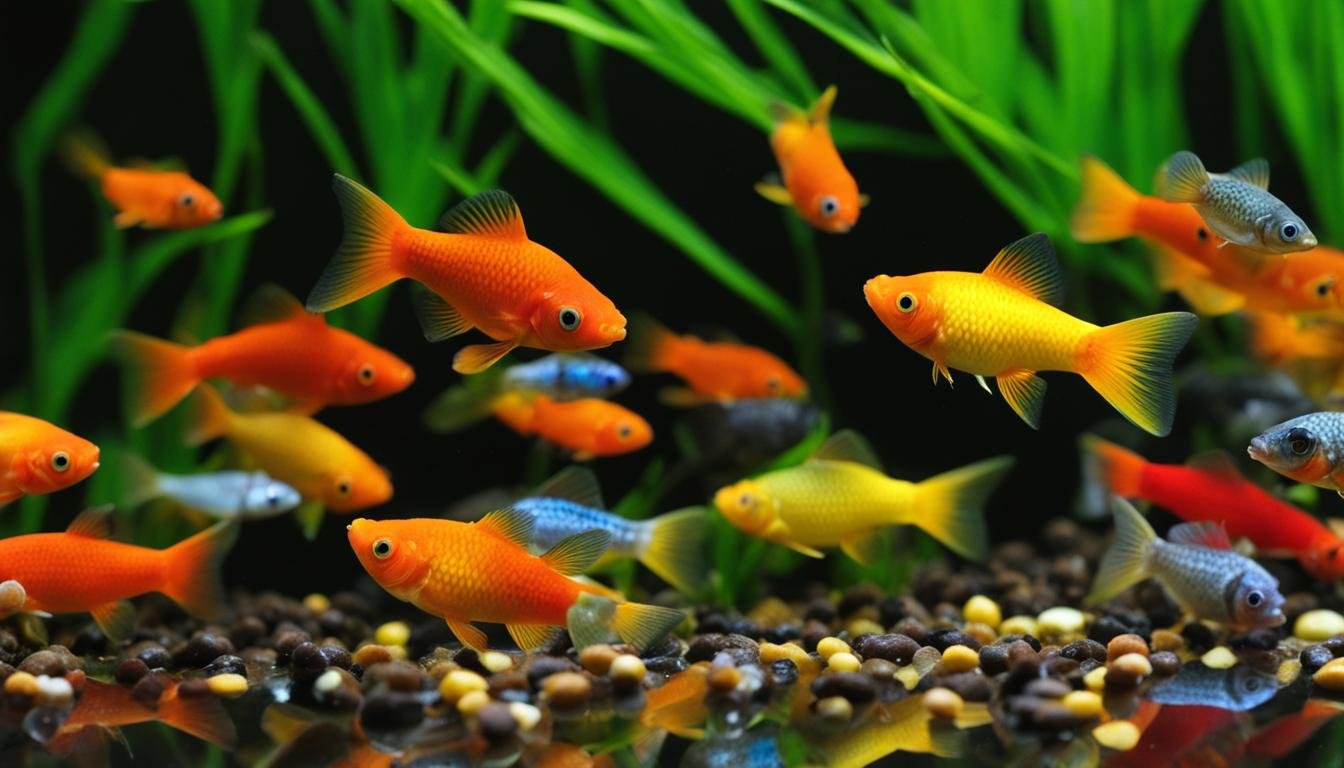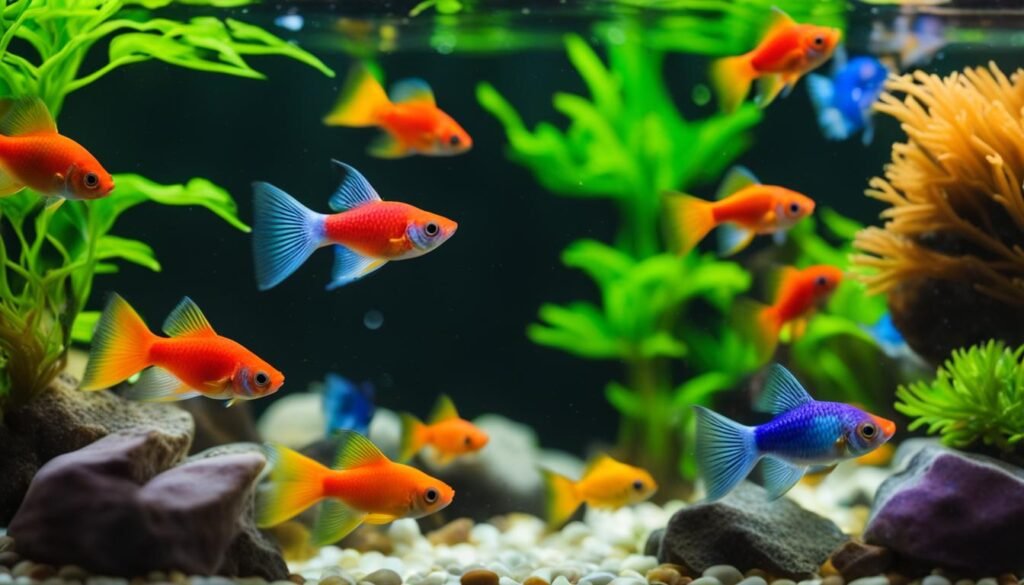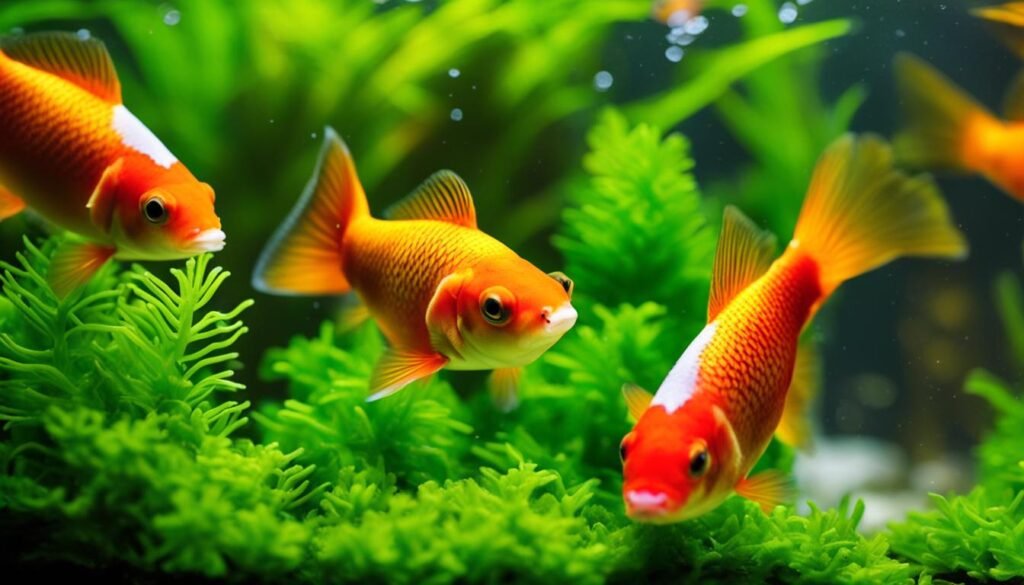Your cart is currently empty!

Uncovering the Diet: What Do Platy Fish Eat?
Welcome to our guide on the diet of platy fish! If you’re a proud owner of these colorful livebearers or considering adding them to your freshwater aquarium, it’s important to know what they eat to ensure their health and happiness.
Platies, native to Mexico and Central America, are versatile omnivores that will eagerly consume a wide variety of foods. From high-quality flakes and pellets to freeze-dried and frozen options, platies have a broad palate. Their diet should comprise a mix of proteins, vegetables, algae, vitamins, and minerals to provide them with a complete and nutritious meal.
Key Takeaways:
- Platies are popular livebearers native to Mexico and Central America.
- They are omnivores and can be fed a diverse mix of proteins, vegetables, algae, vitamins, and minerals.
- High-quality flakes, pellets, freeze-dried foods, and frozen foods are suitable for their diet.
- Ensure a varied and balanced diet for optimal health and nutrition.
- Platies should be given a diverse mix of proteins, vegetables, algae, vitamins, and minerals for a complete and nutritious diet.
About Platy Fish
Platy fish, also known as platies, are a popular choice for freshwater aquarium enthusiasts. These colorful livebearers originate from Mexico and Central America. They come in various types and colors, including Mickey Mouse, sunburst, red wag, blue, bumblebee, and green lantern platies. With their vibrant hues and interesting patterns, platies add a splash of color and liveliness to any aquarium.
Platies are relatively small in size, growing to around 2-3 inches in length. They have a lifespan of 3-4 years when provided with proper care and optimal conditions. These fish are affordable and readily available, with prices ranging from $2 to $4 each, making them an attractive choice for beginners and experienced hobbyists alike.
Platy Fish Types
- Mickey Mouse Platy: Named for their unique black and white markings that resemble Mickey Mouse’s silhouette.
- Sunburst Platy: Known for their vibrant orange and yellow colors that resemble a radiant sunburst.
- Red Wag Platy: Characterized by their red body and distinct wagging tail fin.
- Blue Platy: Exhibiting beautiful shades of blue that vary from light sky blue to deep navy.
- Bumblebee Platy: Adorned with bold black and yellow stripes, reminiscent of a bumblebee.
- Green Lantern Platy: Sporting striking green hues that resemble the glow of a lantern.
When selecting platies for your aquarium, look for healthy fish with bright eyes, full bellies, and active behavior. Choosing a mix of different colors can create a visually appealing and diverse community tank.
Platy Fish Lifespan and Cost
Providing appropriate care and tank conditions can help maximize the lifespan of your platy fish. With an average lifespan of 3-4 years, these energetic fish can bring joy to your aquarium for several years. As for the cost, platies are an affordable option for fishkeepers. Prices typically range from $2 to $4 per fish, making them a budget-friendly choice for both beginners and experienced hobbyists.
Setting up a Platy Fish Tank

When it comes to setting up a tank for your platy fish, there are a few key considerations to keep in mind. First and foremost, you’ll need to determine the size of your tank. Platies can be housed in a 10- to 20-gallon aquarium or larger, depending on the number of fish you plan to keep. A larger tank will provide more swimming space and help prevent overcrowding.
Next, it’s important to create the right environment for your platies. They prefer higher pH and harder water, so you may need to adjust your tap water accordingly. Adding minerals to soft water can help achieve the optimal water parameters for your fish. Additionally, platies appreciate the presence of live aquarium plants in their tank. Not only do these plants provide hiding places and cover, but they also contribute to water quality maintenance.
When selecting tank mates for your platies, it’s best to choose similar-sized community fish. Good options include tetras, rasboras, cory catfish, snails, plecos, and rainbowfish. However, it’s important to note that platies can also be kept with betta fish, provided there is enough space and hiding spots for each fish. Creating a harmonious and peaceful tank environment is essential for the well-being of your platies and their tank mates.
Feeding Platy Fish
When it comes to feeding your platy fish, providing them with a diverse and balanced diet is essential for their health and well-being. These omnivorous creatures will happily devour almost anything you put in their tank. Offering a wide variety of foods will ensure that they get all the necessary nutrients for a complete and nutritious diet.
Best Food for Platy Fish
- High-quality flakes: Choose flakes specifically formulated for tropical fish to provide a staple source of nutrition.
- Pellets: Opt for pellets that sink slowly to allow all the fish to feed properly.
- Freeze-dried and frozen foods: Supplement their diet with freeze-dried or frozen bloodworms, brine shrimp, and daphnia. These foods are high in protein and offer variety.
Natural Diet for Platy Fish
In their natural habitat, platy fish feed on a variety of foods, including small insects, worms, algae, and plant matter. Replicating this natural diet in your tank is beneficial for their overall health. Providing them with a mix of proteins, vegetables, algae, vitamins, and minerals will help ensure that they receive a well-rounded diet.
Feeding Requirements for Platy Fish
Adult platy fish can be fed once a day, while growing juveniles may benefit from two to three small meals throughout the day. Be mindful not to overfeed them, as this can lead to health issues and water quality problems. Keep an eye on their poop – long strings of poop constantly dangling from the platies are a sign of overfeeding. It’s also important to note that platy fish can go without food for a week or less but for longer periods, it’s best to use an automatic fish food feeder or find a reliable pet sitter.
Breeding and Reproduction of Platies

Platies are fascinating livebearers that reproduce by giving birth to live young, making their breeding process unique and exciting for aquarium enthusiasts. Female platies can produce a large number of fry, usually between 20 and 50 babies per month, contributing to their popularity among breeders. Unlike fish that hatch from eggs, platy fry have a relatively high survival rate, which is another reason why they are commonly bred in aquariums.
When breeding platies, it’s important to create a suitable environment for the fry to thrive. Providing hiding spots, such as plants or decorations, is crucial to protect the vulnerable fry from being eaten by adult platies. Additionally, covering the filter intake tube with a pre-filter sponge prevents the fry from being accidentally sucked up and helps increase their chances of survival.
If you find yourself with an abundance of platy fry, there are several options to manage their population. You can give the excess fry away to other aquarium enthusiasts, donate them to a local pet store, or even sell them to fish stores. This not only helps control the population in your tank but also allows other hobbyists to enjoy these beautiful fish. Remember that adult platies do not display parental care and may prey on their own young if given the opportunity.
Key Points:
- Platies reproduce by giving birth to live young.
- Female platies can produce between 20 and 50 fry per month.
- Fry survival rate is higher compared to fish that hatch from eggs.
- Providing hiding spots and covering the filter intake tube helps increase fry survival.
- Excess fry can be given away, donated, or sold to manage population.
Housing and Care Tips for Platy Fish

Proper housing and care are essential for the health and well-being of platy fish. By creating the right tank conditions and providing appropriate care, you can ensure that your platies thrive in their environment.
Housing:
- Platies are relatively small fish, so a well-maintained 10-gallon tank is suitable for a small group of three to six individuals.
- However, larger tanks are recommended to prevent overcrowding and excessive breeding.
- Ensure the tank has a tight-fitting lid to prevent the fish from jumping out.
Tank Conditions:
- Platies prefer higher pH and harder water, so consider adding minerals to soft tap water to create the ideal conditions.
- Maintain a stable temperature between 70-82°F by using a heater if necessary.
- Provide a variety of hiding places, such as live plants and aquarium decorations, to make the platies feel secure.
Water Parameters:
- Keep the water clean and well-filtered to maintain optimal water quality.
- Perform regular water changes of 25% every two weeks to remove accumulated toxins and maintain a healthy environment.
- Test the water regularly using a reliable test kit to monitor parameters such as ammonia, nitrite, nitrate, pH, and temperature.
By following these housing and care tips, you can provide a suitable and comfortable home for your platy fish, ensuring their overall well-being and longevity.
Tank Mates for Platy Fish

When it comes to choosing tank mates for your platy fish, there are several options that can create a harmonious and visually appealing aquarium. Platies are friendly and sociable, making them compatible with a variety of fish species. Here are some recommendations for tank mates that can coexist peacefully with your platies:
- Tetras: Small tetra species like neon tetras and cardinal tetras can be great companions for platies. They add vibrant colors and movement to the tank without posing a threat to your platies.
- Rasboras: Harlequin rasboras and celestial pearl danios are peaceful fish that can happily coexist with platies. They prefer similar water conditions and make excellent tank mates.
- Cory Catfish: Cory catfish, such as panda corys and peppered corys, are bottom-dwelling fish that can help keep the tank clean. They are peaceful and won’t bother your platies.
- Snails: Snails, like nerite snails and mystery snails, can be beneficial to your platy tank. They help keep algae under control and add interest to the tank with their unique shells.
- Plecos: If you have a larger tank, consider adding a pleco to your platy community. Plecos are excellent algae eaters and can coexist peacefully with platies as long as there is enough space.
- Rainbowfish: Melanotaenia species of rainbowfish, such as turquoise rainbows and boesemani rainbows, make beautiful companions for platies. They are peaceful and add a stunning splash of color to the aquarium.
Keep in mind that the compatibility between platies and other fish species may vary depending on individual temperament and water conditions. It’s important to observe the behavior of your fish and make adjustments if any aggression or stress is detected. Providing plenty of hiding spots and visual barriers, such as live plants or decorations, can also help reduce territorial disputes.
In addition, it’s worth noting that while platies can be kept with betta fish, caution should be exercised. Betta fish can be territorial, and not all individuals will tolerate the presence of platies. If you decide to house them together, ensure your tank is spacious enough and provides adequate hiding spots for both species to establish their territories.
Overall, selecting the right tank mates for your platy fish can create a dynamic and visually appealing aquarium. By choosing species that are compatible in temperament and water conditions, you can create a harmonious environment where your platies can thrive alongside their tank mates.
Live Plants for Platy Fish

Adding live plants to your platy fish tank can provide numerous benefits for both the fish and the overall tank ecosystem. Live plants offer natural hiding spots for platies, which can help reduce stress and create a more comfortable environment. They also serve as a natural filtration system, helping to absorb excess nutrients and maintain water quality. The presence of live plants can mimic the platies’ natural habitat, making them feel more at home and encouraging natural behaviors.
When choosing live plants for your platy fish tank, consider species that are compatible with the platies’ environment and behavior. Anacharis is a popular choice as it grows quickly, provides cover for the fish, and can be nibbled on for added nutrition. Floating Indian Fern is another excellent option, with its roots offering feeding spots for platies and its soft leaves being a tasty treat.
Other suitable live plants for platy fish tanks include Java moss, water sprite, and various dense plants that provide hiding spots for fry. These plants not only enhance the aesthetics of the tank but also contribute to the overall health and well-being of the platies. Just be sure to properly care for the live plants by providing adequate lighting, substrate, and regular maintenance.
Benefits of Live Plants in Platy Fish Tanks:
- Provide natural hiding spots for platies
- Contribute to a more comfortable and stress-free environment
- Absorb excess nutrients and help maintain water quality
- Mimic the platies’ natural habitat and encourage natural behaviors
- Enhance the aesthetics of the tank
- Offer additional nutritional sources for the platies
Overall, incorporating live plants into your platy fish tank can greatly enhance the health and well-being of your fish. They offer a multitude of benefits, both visually and functionally, creating a thriving aquatic ecosystem that closely resembles the platies’ natural environment. So go ahead and bring some life to your tank with beautiful live plants!
Conclusion
In conclusion, platies are versatile and easy-to-care-for fish that make a great addition to any freshwater aquarium. Their diet should consist of a variety of high-quality foods to ensure they receive all the necessary nutrients for a healthy life. From high-quality flakes to freeze-dried and frozen foods, platies have a diverse palate.
When it comes to tank size, a 10- to 20-gallon tank or larger is recommended to provide enough space for platies to swim and thrive. Additionally, choosing suitable tank mates is important for a peaceful community. Consider adding tetras, rasboras, cory catfish, snails, plecos, rainbowfish, or even bettas to your platy tank.
For a more natural and visually appealing aquarium, live plants can be incorporated. Plants not only provide hiding spots for platies but also contribute to water quality by absorbing excess nutrients and mimicking their natural habitat.
By following these care guidelines and providing a well-balanced diet, appropriate tank size, suitable tank mates, and the addition of live plants, you can ensure that your platies will live a healthy and fulfilling life in your aquarium. Enjoy the colorful and lively presence of these wonderful fish in your aquatic world.
FAQ
What do platy fish eat?
Platies are omnivores and will eat virtually anything you put in the tank. They can be fed a wide variety of foods such as high-quality flakes, pellets, freeze-dried foods, and frozen foods. Provide them with a diverse mix of proteins, vegetables, algae, vitamins, and minerals for a complete and nutritious diet.
What types and colors of platy fish are available?
Platies come in various types and colors, including Mickey Mouse, sunburst, red wag, blue, bumblebee, and green lantern platies.
How long do platies live?
Platies can live up to 3-4 years in optimal conditions.
How much do platies cost?
Platies are relatively inexpensive, with prices ranging from $2 to $4 each.
What size tank do platies need?
Platies can be housed in a 10- to 20-gallon aquarium or larger.
What water conditions do platies prefer?
Platies prefer higher pH and harder water.
What can platies be kept with?
Platies can be kept with similar-sized community fish such as tetras, rasboras, cory catfish, snails, plecos, and rainbowfish. They can also be kept with betta fish in a spacious aquarium with enough territory for the betta.
How often should platies be fed?
Adult platies can be fed once a day, while growing juveniles prefer two to three small meals a day.
How many babies do platies give birth to?
Female platies can give birth to 20 to 50 babies per month.
What can I do with excess platy fish fry?
Excess fry can be given away, donated to a pet store, or sold to local fish stores.
What tank mates are suitable for platy fish?
Suitable tank mates for platies include small tetras, rasboras, cory catfish, snails, plecos, and rainbowfish.
Can platies be kept with betta fish?
Platies can be kept with betta fish as long as there is enough space and hiding spots for each fish.
Do platies need live plants in their tank?
Live plants can be beneficial for platies as they provide additional hiding spots, help maintain water quality, and mimic their natural environment.
How do I care for platy fish?
Platies are relatively easy to care for. They thrive in a well-maintained tank and prefer higher pH and harder water. A heater may be necessary to maintain optimal temperature.
Leave a Reply